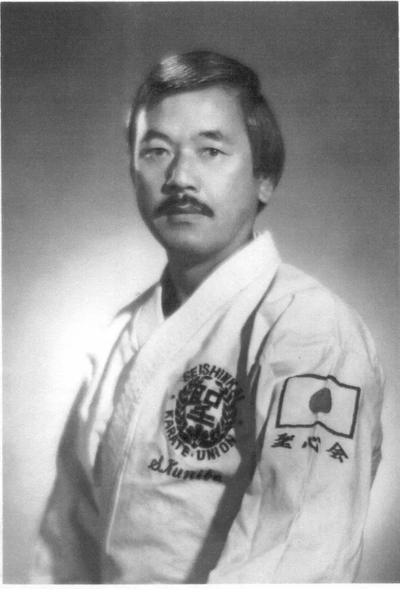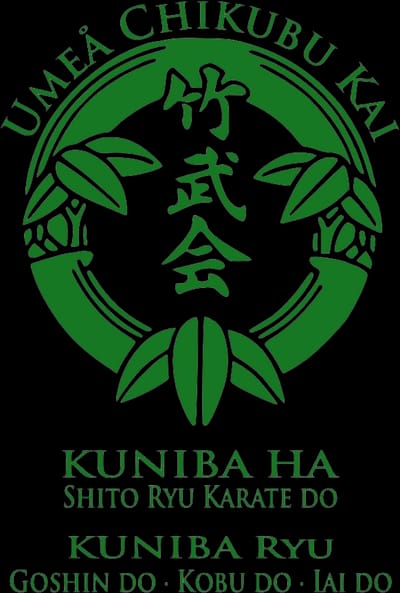Våra stilar


KARATE
We practice traditional karate, a basic style called Motobu-ha Shitoryu, or Kuniba-ha Karate do. It follows the basic style of "Shitoryu", but has since been developed by our first Soke (style leader) Shogo Kuniba.
The training consists of kihon (basic techniques), kata (movement patterns) and kumite (fighting). In traditional karate-do, kata has a particularly large meaning. Application of kata techniques (so-called bunkai) is very important to us.
Shitoryu karate-do
In karate it is usually said that there are four "basic styles". We train the one called Shitoryu (the other three are called Shotokan, Gojuryu, and Wadoryu). Typical for Shitoryu are relatively high stances, short movements in the blocks, hip rotation in the techniques, pull back in punches and kicks and fast straight forward attack. Lineages of the style lead us back to the Shorinryu and Gojuryu styles. The techniques are a mix between the fast explosive Shuri-te style and the gentle Naha-te where the famous breathing exercises are found. As an example, the katana Tensho can be mentioned. An interesting observation is also that our high positions are largely due to the fact that in kata application (bunkai) we strive to be as close to reality as possible. Due to impressions from different karate schools and the interest in tool training (kobudo), people usually call Shitoryu a "multi-karate".
The name Shitoryu is a combination of the writing characters (kanji) of the masters Kenwa Mabuni, Shitoryn's founder, Higaonna and Itossu. At the bottom of this page there is further information on the history of karate.
In Sweden today, a large number of schools which practice Shitoryu karate. Between the schools there is a great understanding and in many cases clear cooperation.
Source: Swedish Chikubu Kai
GOSHINDO
Goshindo is a Japanese complete self-defense, developed by Shogo Kuniba, who, among other things, a. police use in the state of Virginia in the United States. This is because Soke Kuniba lived and developed his Budo there. Suitable for women, men and children.
At Umeå Chikubukai, we train Kuniba ryu Goshindo together with our Karate. When you graduate in karate, you also graduate in Goshindo. This means that 9 kyu yellow belt in Karate is automatically the same degree in Goshindo.
It can be said that Goshindo is a deeper understanding of karate and in many cases an application of karate techniques.
Practicing Goshindo
Studying Goshindo is like becoming like bamboo:
Empty....Pure Heart, Mind, Spirit.
Flexible…Able to bend when needed without breaking.
Stable.... Solid foundation of technology and tradition.
Straight... Clear goals in growing; high ideals.
HISTORY
Kosho Kuniba (Shogo Kuniba) was the master who developed the Goshindo we practice today. He was born in 1935 near Mount Fuji in Japan.
Already as a little boy of about 4 years, he was encouraged to train hard and purposefully by his father (Kokuba Kosei). Kokuba was the one who carried on the tradition of Motobu Choki by becoming the second Soke (family leader) of the Ryu-Kyu Motobu-ha karate system. This happened in 1947 when Soke Motobu died.
Shogo Kuniba had the privilege of training for many famous masters. Both Karate, Judo, Aikido, Jujitsu. When Shogo was only 5 years old, Kokuba (the father) started a lifelong "training camp" for his son who would prove to be very receptive. Since the family came from a samurai family, the father wanted Shogo to be trained in the same spirit as a true samurai. Therefore, young Shogo had to train several different martial arts to become a complete warrior. At first he trained under his father, who passed on Motobu's techniques to his son. This was supplemented by training together with Mabuni Kenwa (founder of Shitoryu). Mabuni taught Shogo many katas and Shitoryu techniques.
As an 8-year-old, Shogo began training Judo under master Itoh Asakichi. Young Shogo was already graded to Shodan at the age of twelve by Kenwa Mabuni, who was also a friend of the father and closely connected with the family. The father and Mabuni saw even here that young Shogo was a grateful subject to learn. Technology and brilliance already as a child.
In 1950 Shogo was graded to Nidan by Mabuni and Tomoyori Sensei. The years followed and Kuniba developed enormously. In 1952, Shogo began training Mugai Ryu Iaido with Soke Ishii Gogetsu in the city of Sakai.
In 1955 Shogo had been awarded Yondan by Mabuni and at the same time started training Okinawa Karate-do with Nagamine Shoshin in Naha city on Okinawa. During his time in Okinawa, Kuniba studied Kobudo under the famous masters Taira Shinken and Nakaima Kenko. He also learned Tonfa under Sensei Kosha Shojin.
By 1958, Shogo had reached the rank of Godan(5 dan) in Motobu-ha Shitoryu karate-do, Yondan(4 dan) in Mugai Ryu Iaido and Rokudan(6 dan) in Kobudo.
Until his death in 1992, Shogo Kuniba had become the third Soke of Motobu-ha Shito ryu karate-do as well as Kuniba ryuo Iaido, Kobudo, Goshindo.
He then held 8 dan in all these branches as well as Motobu-ha Shitoryu Karate-do 9 dan. Kuniba received a posthumous 10 dan (after his death).
With all these things (and much more besides) Shogo Kuniba was able to create his own style of self-defense which he first called Goshin Budo. Later Kunibaryu Goshindo. This system was first developed when Shogo traveled to the United States a few times. He noticed there that he needed something "beyond" his karate to make the species as realistic and functional as possible. He then developed his Goshindo between 1971-1982. Another aspect was that the Japanese were by nature very traditional and did not want to work with much other than kata, kihon, kumite.
As Shogo developed his Goshindo, he noticed that people were confused by all the techniques he was teaching. He then decided to systematize the techniques by putting them together into kata!
These kata systems are used today by those of us who practice Kunibaryu Goshindo. However, there is only the Shoden tradition (first), in use today (Shoden 1-5). These focus on defense against various holds primarily and kick/punch defense secondarily. Shogo Kuniba had three additional systems in development but unfortunately they probably died when he died in 1992 as a result of unstoppable stomach cancer.
A great loss for the Budo world. Shogo Kuniba was a true master who is still missed by many today. The tradition is now carried on through the son and 4 Soke Kozo Kuniba who is the leader of Kuniba kai International.
Shogo Kuniba 1935-1992
Text: Shihan Johan Backteman
Source: History Shogo Kuniba/t-en-us/www.kunibakai.se?w=6650239
History of Goshin Do by James Herndon
IAIDO
Iaido is the art of drawing and handling the Japanese sword. From the beginning, Iaido was created to be used and functioned in combat and the training had combat as its main purpose. Today, the same techniques are practiced as then, but with a different purpose. Iaido is practiced alone against imaginary opponents according to a carefully determined movement pattern. You train to practice your intuitive action, to maintain calm in stressful situations, balance, harmony and concentration, out of a general interest in Japan, Japanese history and Japanese weapons.
What is the historical background?
Ever since the first Japanese swords began to be forged in the eighth century, people have also trained themselves in the art of using them in battle.
It would take several hundred years before the techniques that are still known and practiced today would take shape. The slightly curved shape of the sword, and the way it was carried at the side of the body, made it quick to draw in a sudden attack.
In the 15th century, Izasa Ieano, founder of the sword school Tenshin Shoden Katori Shinto Ryu, began to develop a system where one directly in the stroke of the sword delivered an attack or performed a parry. However, it is believed that the person who really pioneered this type of sword training was Hayasuizake Jinsuke Shigenobu (1546-1621). He founded a sword school and named it Shinmei Muso ryu which became the basis of the modern Iaido.
Mugai Ryu
Of the four main Japanese styles Mugai Ryu, Muso Shinden Ryu, Eishin Ryu and Hoki Ryu, Mugai Ryu is the least known in the West. Mugai-ryu was founded by Tsujigettan or Heinai (1650-1728). A variant of Mugai Ryu that has gained many practitioners in Sweden is Kuniba Ryu.
The version of Kuniba Ryu has Shogo Kuniba as its originator. Soke Shogo Kuniba was born 1935-1992 in Yamanashi in Japan. He studied between 1952-1958 under the 14th generation master Mugai Ryu Soke Ishii Gogetsu.
How to practice Iaido?
Iaido is a martial art where you train with a sword. You use a sword, real or a training sword. Iaido is trained alone without a partner and the aim is to achieve perfection in the movements. An Iaido form can be divided into the following parts:
Maai (the sense of an intuitive distance)
Nuki-tsuke (sword stroke)
Kiri-tsuke (chopped)
Chiburi (symbolic removal of the blood from the blade)
Noto (the sheath of the sword)
... and finally...
zanshin (the mental follow-up) In this way, you practice series of forms that contain the mentioned basic elements in different ways. The exercise is performed in silence as a kind of movement meditation.
KOBUDO
Practicing Kobudo and Iaido does not mean that you should become dependent on the equipment, but that you should gain an understanding of how to handle them and knowledge of how to move in a situation with respect so that you avoid being hit and the training gives strength in joints and muscles and also strengthens the psyche.
History
In 1956, Shogo Kuniba (1935 -1992) traveled back to his father's, Nidai Soke Kosei Kokuba (1900-1959), hometown on Okinawa to study karate in the city of Naha under Nagamine Soshin and at the same time he trained Kobudo, weapons under Sensei Taira Shinken and Sensei Nakaima Kenko. With Sensei Kosha Shojin he trained Bo and Nunchaku, and with Sensei Yamaguchi Junko he trained Tonfa. Sensei Taira Shinken was one of the most famous Kobudo masters and he studied under Sensei Yabiku Moden who founded the Kobudo organization Kyukyu Kobujutsu Kenkyu-Kai. The classic Okinawan weapons include eight different tools, including Bo or Kon (wooden staff), Tonfa (wooden baton), Sai (iron forks), Kama (sickles), Nunchaku ("karate sticks"), Eku (oar) and Tekko (brass knuckles) etc.
Shogo Kuniba was the first karate practitioner to demonstrate Okinawa Kobudo techniques in Japan. In 1970 he was chosen by the Nippon karate-Do Rengo kai, to demonstrate Kobudo at the first Japanese Karate Championships held at the Budokan in Tokyo, Japan.
In 1972, he was once again honored to represent Nippon karate-Do Rengo kai, this time as the sole representative of Japanese karate at the Second World Karate Championship held in Paris, France.
Shogo Kuniba received Kudan, 9th Dan black belt, in Karate-Do and Hachidan, 8th Dan black belt in Iaido Mugai ryu under 14th Soke Ishii Gogetsu in the city of Sakai, Kobudo and Goshin-Do.
Grading criteria
To graduate in Kobudo, a minimum of 9th kyu is required in Karate-Do, regardless of style affiliation.
Degrees you obtain in Kobudo are outside of your own karate degree, you can e.g. have Shodan in Karate and Jo-kyu in Kobudo. You cannot grade Kobudo above your own karate grade, but hold the same grades. When graduating, you don't change your belt or receive a dash, the degree is proven by a diploma. Other styles that do not belong to Kuniba Kai Karate-Do are welcome to graduate within Kuniba Ryu Kobudo.
Why you should grade in Kobudo and Iaido
Kuniba Kai emphasizes that knowledge in the classic Okinawan weapons is maintained and developed. Kobudo is an extension of the karate techniques such as punches and kicks, and through tools you can keep a longer distance to an opponent also Iaido was originally created as a way for practitioners of kendo to learn how to handle Katana, the Japanese sword handling.
Source: www.kunibakai.se



